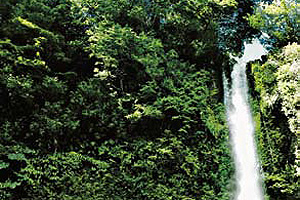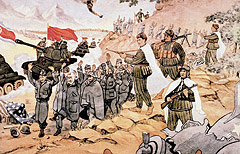The Araucanía has an ecological landscape very akin to the Region of the Biobio, though in this territory, due to a climate that becomes more cold and humid, the hydrophilic species achieve a greater development. Thus, a great number of ferns and epiphyte plants can be found.
– Humid coastal deciduous forest: it develops at the coastal zone. However, as we advance southwards it becomes to disappear, giving way to a laurel like forest, that has an undergrowth with plenty ferns such as the Palmilla (Blechnum auriculatum), the Inquide (Blechnum blechnoides) and the Quiquil (Blechnum chilensis), and epiphyte such as the Estrellita (Asteranthera ovata) and the Quilloiquilloi (Stellaria cuspidate).Besides, in this sector develops trees such as the Olivillo (Aextoxicon punctatum), the Coique (Nothofagus dombeyi), the Tineo (Weinmannia trichosperma), the Tepa (Laurelia philipiana), the laurel (laurus nobilis), the Ulmo (Eucryphia cordiffolia), the Avellano (Gevuina avellana), the Maqui (Aristotelia chilensis), the canelo (Drimys winteri) an the Araucaria (Araucaria araucana). Also grow some plants such as the Pitra (Myrceugenia planipes), trhe Fucsia or Chilco (Fuchsia magellanica), the Murta (Ugni molinae), the Quila (Chusquea quila) and the Chjarquita (Nertera granadensis).
Among the fauna that stands out most is the Monkey of the Hill (Dromiciops gliroides), the Rat-Eared Bat (Myotis chiloensis), the Red Bat (Lasiurus borealis), the Long-Haired Little Mouse (Abrothrix longpilis), the Valdivian Mople Rat (Geoxus valdivianus), the Coipo (Myocastor coypus), the Quique (Galictis cuja) and the Pudu (Pudu opudu). Also, there are numerous birds such as the Cachaña (Enicognathus ferrugineus), the Choroy (Enicognathus leptorhynchus), the Pitío (Colaptes pitius), the Pimpollo )(Rollandia Rolland), the Huala (Podiceps major), the Kingfisher ( Ceryle torquata) and the Picurio (Podilymbus podiceps).
-Southern deciduous forest: it develops at the intermediate depression sector and is dominated by species such as the Roble (Nothofagus oblique), the Laurel ( laurus nobilis), the Maqui (Aristotelia chilensis), the Quila (Chusquea quila), the Lingue (Persea lingue), the Long-Leaved Mañio (podocarpus saligna), the Olivillo (Aextroxicon punctatum), the Luma (Luma apicultata) and the Chile bells (Lapageria rosea). Regarding the fauna stands out some birds such as the Patridge (Nothoprocta perdicaria), the Dancer (Elanus leucurus), the Turtledove (Zenaida auriculata), the Bandurria (Theristicus caudatus), the Southern Huedhued (Pteroptochos tarnii), the Chilean Swallow (Tachycineta meyeni), the Chirihue (Sicalis luteola), the Loica (Sturnella loyca), the Diucón (Pyropppe pyrope) and the Goldfinch (Carduelis barbatus). While, the mammals inhabiting in this zone are exotic or introduced and among them are hares, rabbits, big rats, mice, rats and guarenes.
– Mountainous deciduous forest: it continues prevailing at the Andean sector, with species such as araucarias. Besides, lengas and coigues can also be found.
Among the fauna, stands out mammals such as the Cougar (Puma concolor), the Chilla Fox (Pseudalopex griseus), the Coipo (Myocastor coypus), the Long-Tailed Rat (Oligorzomys longicaudatus) and Olive Colour Little Rat (Arbothrix olivaceus).
Some of the birds inhabiting this palec are the Black Woodpecker (Campephilus magellanicus), the Choroy (Enicognatus leptorhynchus), the Aguilucho (Buteo polyosoma), the Cachudito (Anairetes palurus), the Traro (caracara plancus) and the Peuquito (Accipiter chilensis).
Protected zones
– Conguillío National Park: it was created in 1940 and is located ate the Andes Ranges 28 km northwest the comuna (county) of Curacautín. It has 60.833 hectares and its main attractions are the Llaima volcano (3.125 masl), the Verde, Captrén and Arcoiris lagoons and the Trufultruful waterfalls. Besides, millenary araucaria forests can be observed.
– Huerquehue Nacional Park: created in 1912 is located at 35 km from Pucón at the pre Andean ranges zone. It has 12.500 hectares and has 17 different sized lagoons that are located within large forests of short leaf mañíos, coigues, lengas and araucarias. Among the lakes stands out the Tinquilco, Verde, Toro and Escondido.
– Nahuelbuta National Park: it was created in 1939 and is located at the highest part of the Nahuelbuta Ranges at 35 km northwest Angol. Besides the prevailing araucarias prevailing in this forest, there are coigues, oak trees and lengas. Among birds and mammals are foxes, chucaos and churrines. In the park, hills do not over overreach the 1.500 masl, being the highest the so-called Piedra El Aguila with a 1.460 masl.
– Tolhuaca National Park: with only 6.474 hectares, created in 1937, is located at the Ranges 34 km southwest the comuna (county) of Curacautín. Its main attractions are the Malleco river 49 meters high waterfall, the Malleco and verde lagoons, the Culebra cascade and the Amarillo and Colomahuida hills.
– Villarrica National Park: created in 1912 is located at the Andes Ranges at 8 km southwest Pucón. It has 63.000 hectares and its main attraction is the Villarrica volcano (2.847 masl) which in one of its slopes has a ski resort. Besides, there are extensive araucaria and lenga forests at the high sectors and rauli, long-leaf mañio and coigues at the low sectors. The forest zones allow the existence of a varied fauna, standing out cougars, chilla foxes, quiques and hill monkeys.
– Alto Biobio Nacional Reservation: located at the Biobio river high basin in the comuna (county9 of Lonquimay was created in 1912. has a surface of 35.000 hectares and is dominated by araucaria forests.
– China Muerta National reservation: created in 1968 is one of the places where the araucaria forests are better preserved.
– Malleco National Reservation: it was created in 1907 and is the first reservation established in our country. Is located at 75 km from Collipulli and is the only one that has an 80% of its surface covered with native forest. This is mainly compound of araucarias and lengas.
– Malalcahuello National Reserve: with a surface area of 13,730 hectares, this reserve was created in 1931. It has a very rough topography and its main attraction is Lonquimay volcano (2,865 masl). Its vegetation is dominated by monkey-puzzles, oaks, raulies and coigües.
– Nalcas National Reserve: it has 17,530 hectares and was created in 1936. Due to the fact that it is right next to Malalcahuello reserve, its vegetation is very similar.
– Villarrica National Reserve: created in 1912, it is located between the comunas of Pucon and Curarrehue. It has 60,005 hectares and presents great monkey-puzzle and lenga beech forests.








 Termina la Guerra de Corea
Termina la Guerra de Corea